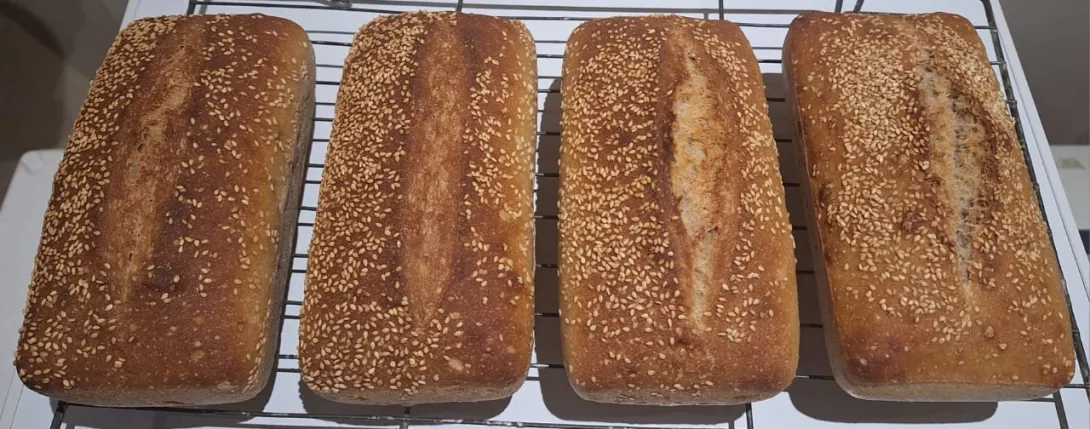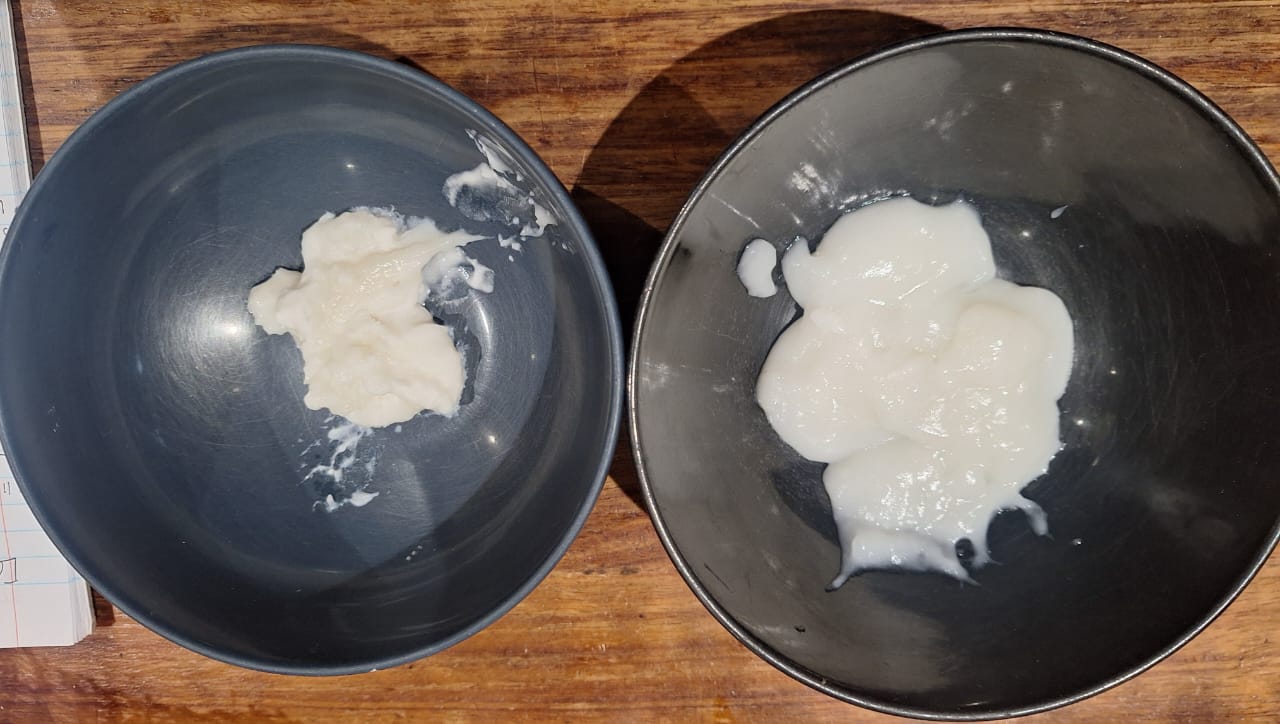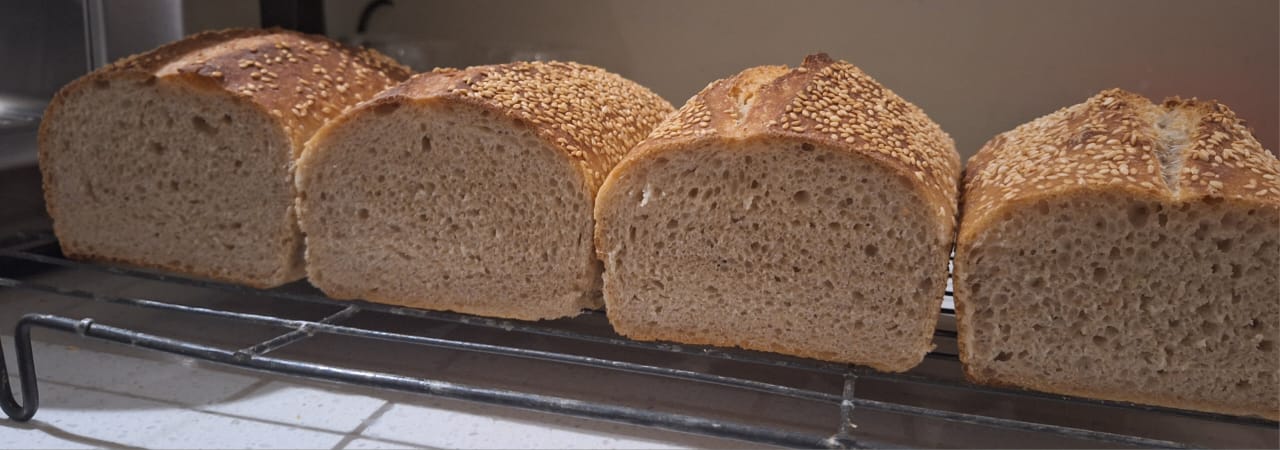
I've recently had a few great bakes that had glutinous rice flour in them and it seemed that it assisted with a strong oven spring, especially if cooked first as a roux (tangzhong/yudane).
To understand it further, let's look at an experimental bake of four small breads (each with 500g of dough and each where 5% of the flour was a rice flour):
- Control bread using regular white rice flour as flour addition.
- Sticky rice as flour addition, not as roux
- Sticky rice roux (200% hydration)
- As per 3 but higher hydration, that's the thing with a roux it makes the hydration behave differently

The roux for bread 3 on the left at 200% hydration; on the right the roux for bread 4 at 600% hydration.
Overall hydration was 67.5% for samples 1-3; for sample 4 the hydration was 85% simply because I made an error with the maths and the tangzhong had a 600% hydration instead of the intended 300% and so it was over hydrated!
The base recipe for each loaf was 208g Caputo Manitoba Oro, 52g spelt wholemeal, 4.7g salt, 150g water, 52g levain, and a roux of 13g glutinous rice flour with 26g of water. This was adjusted as follows: for sample 1 glutinous rice flour was swapped with regular white rice flour; for samples 1 and 2 no roux made and the 26g of additional water added to the base water (176g of water); for sample 4 the roux was 13g glutinous rice flour with 78g water and it had a higher hydration than the other 3 breads.

From left to right breads 1 to 4.
As you can see from the photos, the expected strong oven spring didn't happen. However breads 3 and 4 with the roux did open properly at the straight score whereas the other two breads did not.

Crumb of breads 1 to 4 from left to right. Bread 4 was over-hydrated. No strong difference in oven spring, altough you can see that the two roux containing breads on the right opened up at the score nicely.
Taste testing notes, subtle differences in flavour: bread 1 was distinctly more sour and the taste of breads 2-4 (containing glutinous rice flour) were preferred. Also, it was noticeable that the texture of breads 3 and 4 was better.
In conclusion - some benefits were there, but were subtle and there was no noticeable improvement in oven spring (unlike what was expected!)
-Jon
- JonJ's Blog
- Log in or register to post comments
I don't know what's with tangzhong though, I don't feel it has the efficacy of yudane/ starchy puree. I feel tangzhong is prone to...what is it... breaking down? whatever-lysis? I made preferment with tangzhong, ended up being soup and losing it's water retention capability. But never happened with potato puree.
However Jon, I think it seems interesting to use cooked rice puree instead with water:rice ratio of risotto/rice pudding. It's been on my mind lately. I'm also curious to compare starchy versus waxy rice varieties.
Nice experiments, Jon!
Jay
What do you think are the differences between a tangzhong and a yudane? Though they are really the same thing, I get the idea that common usage has a yudane made by dumping boiling water over the starch/flour and stirring, whereas a tangzhong involves heating a mixture of water and starch/flour at a temperature close to 165 deg F (so "cooking", maybe, but no boiling). Both ways try to avoid inactivating enzymes with too high a temperature (the boiling water will cool down before it hits most of the solids) since the hope is to activate the enzymes in addition to gelatinizing the starch.
TomP
Thanks Tom for setting my thinking on a different path. What I did here was pour boiling water on top and then stir over heat perhaps for 1 to 2 minutes. With glutinous rice flour it doesn't come together straight away, you need to stir until it also shows distinct "glassiness".
Your comment has now made me think I might have denatured enzymes by starting with boiling water.
I had previously seem some signs that the roux made with glutinous rice did result in amazing oven spring, so was a bit flummoxed by this bake that there was no effect at all, perhaps though the method of preparation of the roux is more important than I thought.
I think it would be worth while to repeat the version with a glutinous rice mix and this time, make the tangzhong by heating the water/rice mixture to about 160 - 165 deg F and holding it in that range for some time. This ought to improve the flavor and release more sugars. If anything's going to cause more oven spring with this rice flour, I would think this way would.
-
Jay you're thinking in wonderful creative ways!
If this one had worked out I might have wanted to play with tapioca starch and corn starch too.
-Jon
I'm glad you got round to conducting these experiments; I was really looking forward to your results.
I was indeed expecting that the roux bread will have a bigger oven spring than the non-roux, so this is really interesting. Perhaps there's something to be said about the elasticity of the glutinous rice roux "pulling back" the dough? Just wild guesses.
Also interesting that the glutinous rice bread produced a less sour bread than the regular rice bread. Is there something about the sugars of regular rice that are more readily available for breakdown than glutinous rice?
I've always gone the tangzhong route for my milk breads so can't comment much on the yudane method! But I agree with Jay that sweet potato puree retains water exceptionally well.
I know, right?! Such funny results!
Also, I used to think that a Tangzhong must have 1:5 flour: water and be cooked on the stove (or microwave) whereas Yudane was 1:1 or 1:2 and the boiling water was just poured on.
But, if you think about it, there are some many different ways and permutations to make it, and Seraphine had a great video, especially about not needing the 1:5 ratio.
So I think I'm going to plant some thoughts about ideas for eventually trying things out (and just leave them there for now) and Tom has also given great ideas.
-Jon
Yudane and tangzhong are written with the same characters, even though they're in two different languages, so more similar than different!
Got sucked into another Seraphine video after my reply above: https://youtu.be/a2Bhe16kvCI where she explains that.
-Jon
Great experiment Jon and thank you for doing this and sharing it with us. I wonder if the amount of rice flour/glutinous rice flour you used was a bit too low to really show what the tangzhong/yudane can do. When I've used tangzhong I have settled on doing about 20% of the total flour in the tangzhong. I've never felt that just pouring the boiling water on the flour really fully gelatinized it when doing a 1:2 ratio of flour to water. It always seems to be looser than I would expect compared with when doing a tangzhong and cooking it.
Nonetheless, great baking you've done.
Benny
Great points Benny, the more that I think about it, I may have played it too conservatively with 5% flour in the tangzhong.
In fact, Mandy Lee's recipe for the bread that started this all off for me has 24% of the flour in the tangzhong. And it is this bread that I found had far less oven spring when that flour wasn't added in as a tangzhong (even though it also has egg whites in the recipe which does confound things as, for sure egg whites do promote oven spring).
-Jon
Interesting Jon.
So Glutinous rice is sticky rice! Had to look that up! I read that the starch in Glutinous rice consists primarily of amylopectin with little to no amylose content compared to regular rice and it is this that accounts for its sticky consistency. Just as Jay did, I made the comparison to floury vs waxy upon learning this. I figured, if glutinous rice were a potato it would be a very waxy potato.
Fun fact: The Irish love their floury potatoes (rich in amylose), as do I. They are fluffy and highly absorbent. Excellent for mash and jackets.
Wheat flour starch typically consists of approx. 25% amylose and 75% amylopectin.
I also read that glutinous rice flour is processed by drying cooked glutinous rice. I think regular rice flour is not cooked, just ground. So regular rice flour would retain intact starch granules (which are unfermentable if not damaged or cooked).
Gelled starch is generally used to bring softness by increasing water holding capacity. I don't know of any rationale of why it would improve oven spring. As mentioned somewhere, amylase activity will slowly breakdown the gelled starch and decrease its water holding capacity. As happens in amylograph analysis.
Yes, glutinous rice is sticky rice and I can only buy glutinous rice flour that originates from Asia (my current bag is from Thailand, I think). I also use it for attempting mochi and interesting Asian-style desserts!
One thing, I do know with my limited knowledge is that the rice flour we get from Asian countries is all wet milled. I thought that meant the rice had been soaked prior to milling (but not cooked). Allegedly this results in a finer and superior flour. The white rice flour in this experiment in bread 1 wasn't from Asia and I think was just regularly dry milled. I have both kinds in my kitchen. And brown rice flour too. Which Jay says isn't a thing in Indonesia, go figure. So, there is a lot of nuance to the variations of rice flour, if you know more do please share.
The glutinous rice tangzhong is awful to work with, it is extremely sticky, as per the name!
-Jon
-
From what I read, indeed wet milling involves soaking without cooking (important) and is considered superior to dry milling for various reasons (purer extraction of starch, finer and even distribution of particles) but also because it reduces starch damage. This is comparable to tempering wheat grain, by increasing moisture in the grain it aids in decreasing starch damage during milling.
On starch granules. Nature packs starch into large granule structures, so tightly constructed they are, water cannot ingress (hence they are less absorbent). When water can't get in, enzymes can get in. When you apply heat these granules rupture and burst open, making the starch available to hydration (and then enzymatic cleavage) and this is why rice dramatically expands in volume when cooked.
Yes, but I have seen people (in the US) call Japanese style rice "sticky rice" as well. If you see the term in a recipe it's well to be cautious about how it's being used.